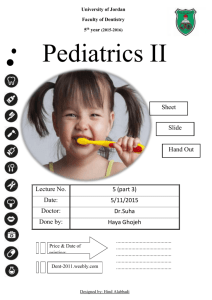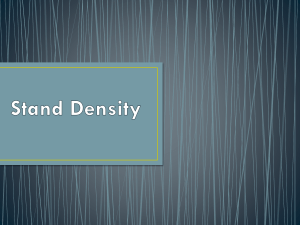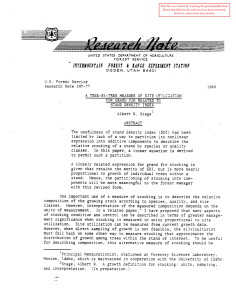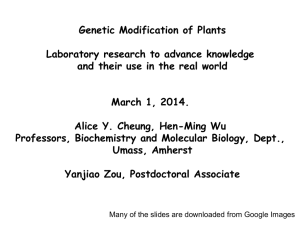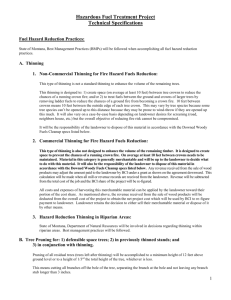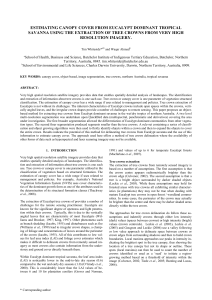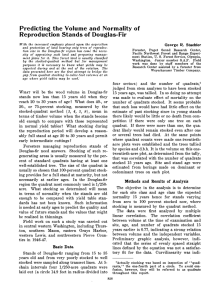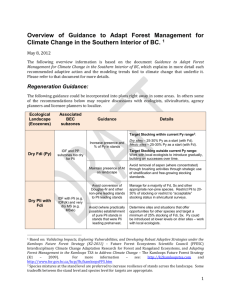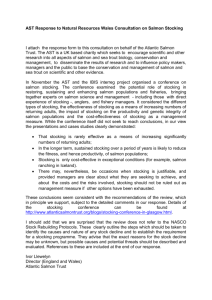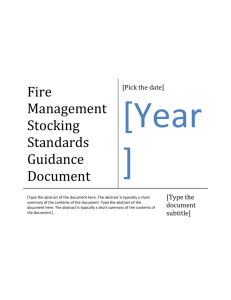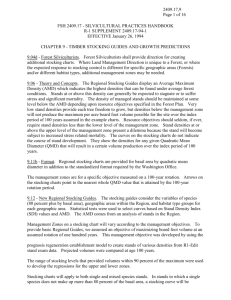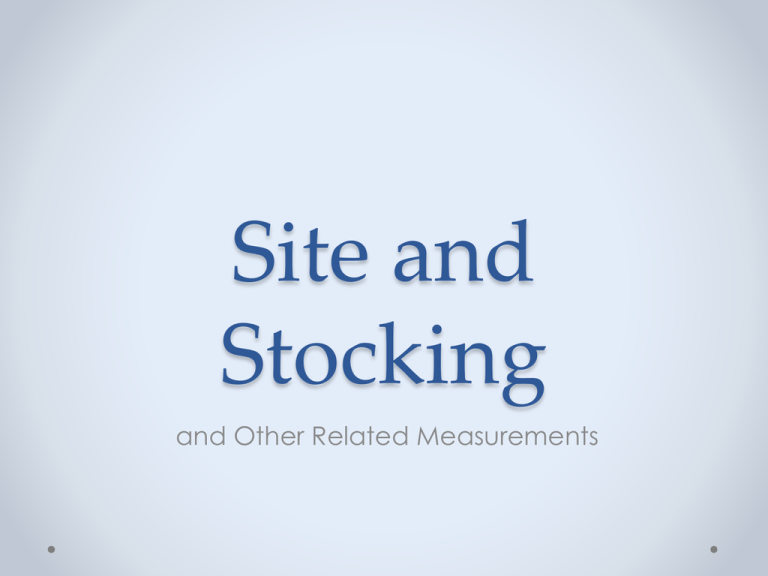
Site and
Stocking
and Other Related Measurements
Height as a Measure of
Site Quality
• Tree Height in relation to tree age has been found
to be the most practical, consistent and useful
indicator.
• What was discussed earlier as the limiting factor to
fast growth?
Site Index
• The average total height and age of dominant and
co-dominant trees in well-stocked, even-aged
stands.
Crown Class
• Dominants - Crowns receive full light from above, and partly
from the side. Trees extend above the general crown levels
• Co-dominants - Crowns form at the general level of the
canopy. Crowns receive full light from above, but little from
the sides.
• Intermediates - Crowns generally below the dominants and
co-dominants, but extending up into the general canopy
level. They receive little or no direct light from above, nor
the sides.
• Overtopped or Suppressed - Crowns entirely below the
general level of the canopy. They receive no direct light
from above, nor the sides.
Crown Class
Crown Closure
Measured by what?
Crown Closure
• Spherical Densiometer
• Hemispherical photography
• Aerial photography
•
•
•
•
•
•
•
CLASSES
Very Sparse 1-9%
Sparse 10-29%
Low 30-49%
Medium 50-69%
Dense 70-84%
Very Dense 85-100%
Tree Age
• Even-aged The range of tree ages generally
does not exceed 20% of the rotation age assumed.
• Uneven-aged - Three or more distinct age classes,
either intimately mixed, or in clumps.
Increment Borer
Site Index
Total Heights and
Ages of dominant
and/or codominant trees are
measured and
curves are fitted.
Varies by species
and region.
Site Index Limitations
1. Exact Stand age is often difficult to determine
(diffuse porous wood, false rings and drought rings,
skill with borer), and small errors can cause
relatively large changes in the site-index estimate.
Alternate methods of determining stand age can
include counting branch whorls (if applicable species)
or historical information
Site Index Limitations continued
2
3
4
5
Not well suited to uneven-aged stands, areas of
mixed-species composition, or open lands.
Stand volume variables (DBH, stem form) are not
taken into account.
Site-Index is not a constant, it changes periodically
with climate and management.
Varies by species within the same site. So if you
plan to change the site to a new species, it is
difficult to predict.
Factors that Influence SI
SI Alternatives
• Growth index
o Tree diameter
o Stand volume
• Output from a mechanistic growth model
o Indicator plants
o NPP, evapotranspiration
• Leaf area index
o Can be assessed remotely
Site Index real world use
•
•
Growth Intercept Models: These speciesspecific models are designed explicitly
for young stands (5-50 years breast
height age). The growth intercept
technique estimates site index from the
average annual height growth of site
trees, which is determined either from
the distance between annual branch
whorls or from the height and breast
height age of the tree.
Site Index-Biogeoclimatic Ecosystem
Classification (SIBEC) Models: This
comprehensive tool correlates site index
with site series within biogeoclimatic
ecosystem classification (BEC) units and
site series. The BEC system is designed
specifically for British Columbia’s
ecosystems. This model is best used for
very young stands, very old stands, and
stands not suitable for other methods.
Indicator Plant Approach
• Curves fitted to
measured
data relating
the presence
of certain
plants to the
site quality for
trees on a
given site.
Site Index from Soil
Soil Survey
• Forest lands
• Site Index - Measurements of site index are usually
extended to a number of like soils where data are
unavailable.
• Erosion hazard
• Equipment limitations
• Seedling mortality
• Windthrow hazard
• Plant competition
• Trees to plant
Site Productivity Measures
Tree Growth
Principles and their implications
General Growth Curve
Change in Tree Weight
Mean Annual Increment
• Increase in cubic-foot volume per acre per year
• Curves fit to known data – usually takes the
equation form below
• MAI = Constant X Site Index +/- Intercept
• Attempts to predict future Annual volume growth
Annual Growth
Increment
Generalized
Chart for
conifers
The concept of forest site productivity in terms of current annual volume increment vs age.
Skovsgaard J P , and Vanclay J K Forestry 2007;81:13-31
© Institute of Chartered Foresters, 2007. All rights reserved. For Permissions, please email:
journals.permissions@oxfordjournals.org
Stocking
Stand Density
Quantitative measurement of the stand describing the
degree of stem crowding within a stocked area.
Growth vs. Growing stock
The thinning response hypothesis.
Skovsgaard J P , and Vanclay J K Forestry 2007;81:13-31
© Institute of Chartered Foresters, 2007. All rights reserved. For Permissions, please email:
journals.permissions@oxfordjournals.org
Assmanns theory of natural, optimal and critical basal area.
Skovsgaard J P , and Vanclay J K Forestry 2007;81:13-31
© Institute of Chartered Foresters, 2007. All rights reserved. For Permissions, please email:
journals.permissions@oxfordjournals.org
Stocking
• A description of the
number of trees, basal
area, or volume per
acre in a forest stand
compared with a
desired level for a
management objective
• Central Hardwood
Stocking Chart
Stocking Charts
• Vary by species
• Vary by site quality
• Compare current stand
conditions to desired in
order to make
prescriptions







